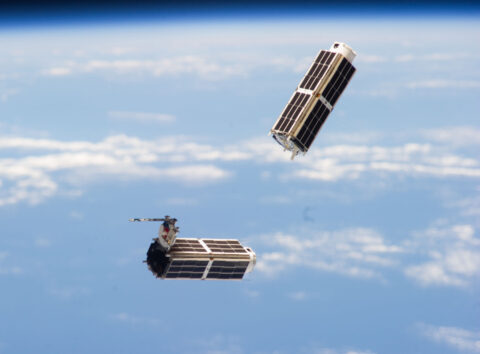Space agencies in the United States and elsewhere are turning to nanosatellites built of one or more 10 × 10 × 11 centimeter cube-shaped units.
A classified U.S. satellite mission that launched this morning deployed more than just a spy satellite. It also released into orbit 13 miniature CubeSats, which hitchhiked aboard the flight.
In a growing trend, space agencies in the United States and elsewhere are turning to such nanosatellites, each built of one or more 10 × 10 × 11 centimeter cube-shaped units, as a compact, low-cost means to conduct scientific research, Earth observation, technology development, and student experiments.
Student Training
Students contributed to several projects that flew aboard the Atlas V rocket launched from Vandenberg Air Force Base in California.

The first CubeSat from Alaska, the Alaska Research CubeSat 1 (ARC-1), will measure the thermal environment inside the launch vehicle, among other tasks. The device began as a training project in space system engineering at the University of Alaska Fairbanks. Graduate student Morgan Johnson, who was team lead on the project, found it “interesting to take this project from what we are learning in school and having it launch in space.”
Today also marked the first time a CubeSat from a Native American tribal college went to space. The 1-kilogram BisonSat includes a camera for Earth observation. “A number of tribal governments are active in using space-based imagery for land decisions,” said principal investigator Tim Olson at an 8 October NASA news briefing. “We hope that our mission is able to contribute to the data sets tribes use.” Students at Salish Kootenai College in Montana helped to develop the satellite.
Demonstrating Data Transfer Rates
“We demand immediate access to our data here on Earth. Why don’t we demand the same of data that has originated from low Earth orbit?”
Several industry-developed CubeSats also rode into space this morning. Aerospace Corporation built AeroCube-5c and AeroCube-7 to demonstrate increased data transfer rates by laser, said John Serafini, vice president of Allied Minds, a company working with Aerospace Corp. “We demand immediate access to our data here on Earth,” Serafini noted at the briefing. “Why don’t we demand the same of data that has originated from low Earth orbit?”
NASA sponsored four of the CubeSats deployed today. The U.S. National Reconnaissance Office sponsored the other nine CubeSats that accompanied the surveillance agency’s classified NROL-55 mission.
By sponsoring CubeSats, NASA aims “to promote small spacecraft as a paradigm shift for NASA and the larger space community,” Steve Jurczyk, NASA associate administrator for Space Technology, said at the briefing.
—Randy Showstack, Staff Writer
Citation: Showstack, R. (2015), U.S. launches 13 new minisatellites, Eos, 96, doi:10.1029/2015EO037163. Published on 8 October 2015.
Text © 2015. The authors. CC BY-NC 3.0
Except where otherwise noted, images are subject to copyright. Any reuse without express permission from the copyright owner is prohibited.

